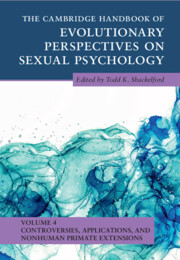Book contents
- The Cambridge Handbook of Evolutionary Perspectives on Sexual Psychology
- The Cambridge Handbook of Evolutionary Perspectives on Sexual Psychology
- Copyright page
- Contents
- Contributors
- Preface
- Part I Controversies and Unresolved Issues
- 1 The Female Sexual Orientation Spectrum in Evolutionary Perspective
- 2 The Evolution of Female Same-Sex Attraction
- 3 Male Bisexuality
- 4 Female Bisexuality
- 5 Masturbation in Primates
- Part II Applications to Health, Law, and Pornography
- Part III Nonhuman Primate Sexual Behavior
- Index
- References
1 - The Female Sexual Orientation Spectrum in Evolutionary Perspective
from Part I - Controversies and Unresolved Issues
Published online by Cambridge University Press: 30 June 2022
- The Cambridge Handbook of Evolutionary Perspectives on Sexual Psychology
- The Cambridge Handbook of Evolutionary Perspectives on Sexual Psychology
- Copyright page
- Contents
- Contributors
- Preface
- Part I Controversies and Unresolved Issues
- 1 The Female Sexual Orientation Spectrum in Evolutionary Perspective
- 2 The Evolution of Female Same-Sex Attraction
- 3 Male Bisexuality
- 4 Female Bisexuality
- 5 Masturbation in Primates
- Part II Applications to Health, Law, and Pornography
- Part III Nonhuman Primate Sexual Behavior
- Index
- References
Summary
Human female sexual orientation has received increased attention from scholars in evolutionary and sexuality-related sciences. As our understanding of female sexual orientation matures, especially same-sex attractions, many of our scientific assumptions must similarly progress. Better operational definitions will help focus current theoretical frameworks for understanding same-sex attraction among females, and guide future refinements to these models. Here we advocate for more precise characterization of the female sexual orientation spectrum, which in turn forces reconsideration of two pervasive assumptions in this domain. The first is that female sexual orientation is accurately characterized as a smooth unidimensional continuum. While concepts and terminology that aid our understanding of female same-sex attraction often convey stepwise gradations along a sexual orientation spectrum, we present relevant considerations for treating categories of female sexual orientation as more dissociable than typically acknowledged. Reframing this discussion leads naturally to reconsidering a second assumption –that all female same-sex attractions require adaptationist explanations, or the same kind of evolutionary account. Here we propose that most female non-heterosexuality poses little or no challenge to Darwinian frameworks, although evolutionary considerations can nonetheless help our understanding of the proximate development of such attractions.
- Type
- Chapter
- Information
- Publisher: Cambridge University PressPrint publication year: 2022
References
- 2
- Cited by



